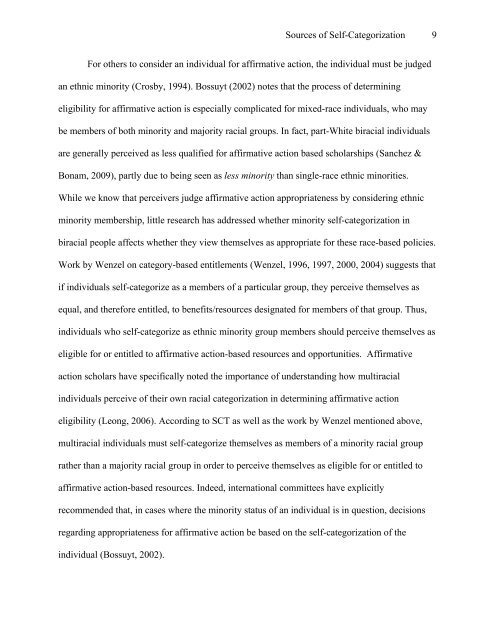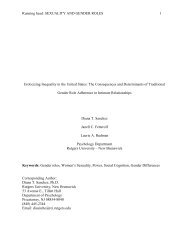Sources of self-categorization as minority for mixed race individuals
Sources of self-categorization as minority for mixed race individuals
Sources of self-categorization as minority for mixed race individuals
You also want an ePaper? Increase the reach of your titles
YUMPU automatically turns print PDFs into web optimized ePapers that Google loves.
<strong>Sources</strong> <strong>of</strong> Self-Categorization 9For others to consider an individual <strong>for</strong> affirmative action, the individual must be judgedan ethnic <strong>minority</strong> (Crosby, 1994). Bossuyt (2002) notes that the process <strong>of</strong> determiningeligibility <strong>for</strong> affirmative action is especially complicated <strong>for</strong> <strong>mixed</strong>-<strong>race</strong> <strong>individuals</strong>, who maybe members <strong>of</strong> both <strong>minority</strong> and majority racial groups. In fact, part-White biracial <strong>individuals</strong>are generally perceived <strong>as</strong> less qualified <strong>for</strong> affirmative action b<strong>as</strong>ed scholarships (Sanchez &Bonam, 2009), partly due to being seen <strong>as</strong> less <strong>minority</strong> than single-<strong>race</strong> ethnic minorities.While we know that perceivers judge affirmative action appropriateness by considering ethnic<strong>minority</strong> membership, little research h<strong>as</strong> addressed whether <strong>minority</strong> <strong>self</strong>-<strong>categorization</strong> inbiracial people affects whether they view themselves <strong>as</strong> appropriate <strong>for</strong> these <strong>race</strong>-b<strong>as</strong>ed policies.Work by Wenzel on category-b<strong>as</strong>ed entitlements (Wenzel, 1996, 1997, 2000, 2004) suggests thatif <strong>individuals</strong> <strong>self</strong>-categorize <strong>as</strong> a members <strong>of</strong> a particular group, they perceive themselves <strong>as</strong>equal, and there<strong>for</strong>e entitled, to benefits/resources designated <strong>for</strong> members <strong>of</strong> that group. Thus,<strong>individuals</strong> who <strong>self</strong>-categorize <strong>as</strong> ethnic <strong>minority</strong> group members should perceive themselves <strong>as</strong>eligible <strong>for</strong> or entitled to affirmative action-b<strong>as</strong>ed resources and opportunities. Affirmativeaction scholars have specifically noted the importance <strong>of</strong> understanding how multiracial<strong>individuals</strong> perceive <strong>of</strong> their own racial <strong>categorization</strong> in determining affirmative actioneligibility (Leong, 2006). According to SCT <strong>as</strong> well <strong>as</strong> the work by Wenzel mentioned above,multiracial <strong>individuals</strong> must <strong>self</strong>-categorize themselves <strong>as</strong> members <strong>of</strong> a <strong>minority</strong> racial grouprather than a majority racial group in order to perceive themselves <strong>as</strong> eligible <strong>for</strong> or entitled toaffirmative action-b<strong>as</strong>ed resources. Indeed, international committees have explicitlyrecommended that, in c<strong>as</strong>es where the <strong>minority</strong> status <strong>of</strong> an individual is in question, decisionsregarding appropriateness <strong>for</strong> affirmative action be b<strong>as</strong>ed on the <strong>self</strong>-<strong>categorization</strong> <strong>of</strong> theindividual (Bossuyt, 2002).



